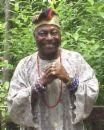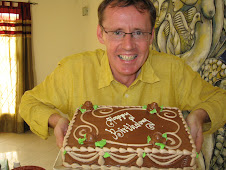Nationality: Nigerian
State of origin: Kogi
The Chief was born October 1, 1919. He is a spiritual leader, artist, herbalist, avid polo player to this day, flutist and film maker. His art is in the collections of the Museum of Modern Art, New York, Queen Elizabeth II, David Rockefeller, and Muhammad Ali.
 Detail van het wandtapijt
Detail van het wandtapijtThe medium: Cotton-cord applique on canvas. Hand-spun and herbal-dyed, applied with wheat paste and set by the weight of a heavy slab of stone. Silk in appearance. Can be rolled, like any tapestry or rug for transport. The drawn pattern is often visible on the back.
Referenties:
Besides the obvious representation of reality, an Oloruntoba painting, may however have other functions not included in that particularly western notion. Many are designed with specific purposes in mind: protecting the possessor, warding off malign influences, emblems of good luck or even as curative of specific ailments or weaknesses. Here. For Oloruntoba, each painting is created in response to a specific question, need or problem and contains its own active spirit. Thus works with titles such as For Harmony, Protection Against Jealousy, and Against Sickness are objects to bring down power and invoke the powerful protection of positive forces from the other side. It is for this reason that such paintings are created with vegetable dyes made from herbs andthe roots of traditional plants, their curative effects being dependent both upon the distinctive colours resulting and upon their inherent herbal properties.

Chief Zacheus Olowonubi Oloruntoba (O-láuren-tóba) was born in 1919 in Ogidi, Nigeria and began painting at 15 years old to explain the powerful, lucid dreams he had had since age 12. In Yoruba tradition, as with many cultures worldwide, dreams have particular significance as a means for the dead to communicate with the living and advise them through their daily lives.
Young Zacheus' dreams were so well-known, he became a spiritual mentor and healer in his village. Chief Oloruntoba credits his mother with teaching him how to use his magical gift of dreams and his grandmother with showing him how to paint.
It was not until 1948 that Chief Oloruntoba began working with hand-dyed cords. He would be unknown as an artist for years to come, focusing instead on becoming an herbal doctor and chief. His art, though a very useful tool, was only one small part of his healing practice.
Before he'd reached his teens, young Zacheus had become known throughout Africa for his powerful, lucid, and seemingly clairvoyant dreams. Many of those dreams were recorded and published by the University of California Press as King Marapaka's Dream. The book presents an evocative tale of a young man's apprenticeship in the healing arts and his eventual mastery of magical powers. Today, Chief Oloruntoba continues to work his magic in paintings that sweep the viewer into a phantasmagoric realm of color, vitality, and mystery.
Working with traditional methods and materials, Chief Oloruntoba tra
 nslates his clairvoyant dreams into what he calls "paintings for power and life and for the protection from sickness and jealousy." The exuberant images of elephants, lions, great birds, Yoruba women, tribal musicians,and village huts have curative powers far beyond the delight they give the viewer. Each contains a healing spirit who has arrived from beyond to grapple with a specific problem or concern--as represented by such titles as Two Protection Birds and Good Luck and Harmony.
nslates his clairvoyant dreams into what he calls "paintings for power and life and for the protection from sickness and jealousy." The exuberant images of elephants, lions, great birds, Yoruba women, tribal musicians,and village huts have curative powers far beyond the delight they give the viewer. Each contains a healing spirit who has arrived from beyond to grapple with a specific problem or concern--as represented by such titles as Two Protection Birds and Good Luck and Harmony.He is also an internationally known herb doctor. After his Wichita, Kansas exhibition in February and March, 1999, he was invited by a professor of Georgetown University Medical School to lecture and conduct a workshop on herbs and their healing power. The Chief also uses the herbs to dye the fiber which he spins. He feels his art is curative to the viewer.
He is first and foremost a spiritual leader of the Nigerian city of Ogidi, a city of the Kogi State, made up of 300,000 people primarily of the Yoruba tribe. He is next in line to succeed his uncle as King of Ogidi. (His uncle is 117 years old.) Following tradition, he will no longer create art when he is king.
'When western medicine fails,' the artist says, 'many African people return to me for guidance, and after consulting with the oracle I create a therapeutic work especially for them. Sometimes this treatment includes the ingesting of herbs and plants similar to those with which I make their painting. The painting is a visible manifestation, a "spirit" of the treatment they must undergo to heal themselves. Painting, you see, like music, also, has strong magical powers.'
Abiola Oloruntoba, a daughter living and working in Atlanta, is a mortgage broker.

Six African Flute Players for Harmony













No comments:
Post a Comment